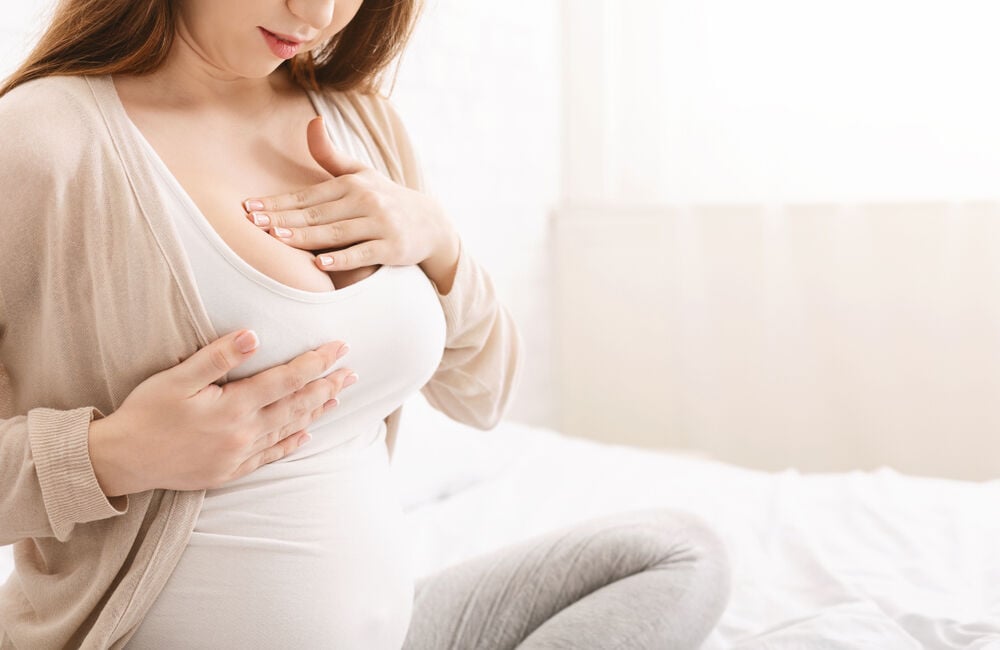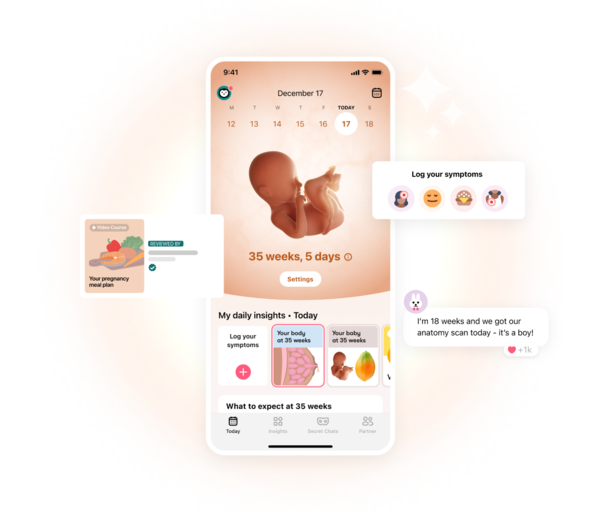Breast changes during pregnancy are incredibly common. For many people, they’re one of the first indications that they’re pregnant! Understanding these changes and knowing how to handle them will prove immensely during pregnancy.
-
Tracking cycle
-
Getting pregnant
-
Pregnancy
-
Help Center
-
Flo for Partners
-
Anonymous Mode
-
Flo app reviews
-
Flo Premium New
-
Secret Chats New
-
Symptom Checker New
-
Your cycle
-
Health 360°
-
Getting pregnant
-
Pregnancy
-
Being a mom
-
LGBTQ+
-
Quizzes
-
Ovulation calculator
-
hCG calculator
-
Pregnancy test calculator
-
Menstrual cycle calculator
-
Period calculator
-
Implantation calculator
-
Pregnancy weeks to months calculator
-
Pregnancy due date calculator
-
IVF and FET due date calculator
-
Due date calculator by ultrasound
-
Medical Affairs
-
Science & Research
-
Pass It On Project New
-
Privacy Portal
-
Press Center
-
Flo Accuracy
-
Careers
-
Contact Us
Breast Changes During Pregnancy: Your Step-By-Step Guide


Every piece of content at Flo Health adheres to the highest editorial standards for language, style, and medical accuracy. To learn what we do to deliver the best health and lifestyle insights to you, check out our content review principles.
Breast changes and early signs of pregnancy
Even before a positive pregnancy test, many women report breast changes as the first indication that they might be pregnant. Because breast changes are also common before or during a period, it can be hard to distinguish between the two, particularly for someone who’s trying to get pregnant or who really doesn’t want to be pregnant.
Breast changes in early pregnancy are the result of an increase in progesterone levels, as well as the initial stages of milk duct growth. Breast sensations may change, as tingling and soreness, usually around the nipples, increases. The breasts may also get larger, while both the nipples and areola become larger and darker.
How your breast changes during pregnancy
There is no definitive way to categorize breast changes during pregnancy according to trimester or week of pregnancy. For most, it makes more sense to classify breast changes during early pregnancy and breast changes in late pregnancy. Even within these classifications, it’s wise to remember that each body is different and typical changes for one person may occur in a different trimester than typical changes for another person.
Major breast changes during pregnancy

While some changes to breasts during pregnancy can be related to weight gain, the majority of breast change and growth is related to milk production. As soon as pregnancy occurs, the breasts begin preparing for breastfeeding. Breast changes during pregnancy are caused by the fluctuations of the hormones progesterone, prolactin, and estrogen. Typical breast changes during early pregnancy may include:
- Tenderness and/or change in breast or nipple sensations
- Changes in color or size of the nipples or areolas
- An increase in breast size
- Larger Montgomery glands (sebaceous glands on the areola)
As you move further into your second trimester, you may notice a small amount of straw-colored fluid leaking from your nipples. This fluid is called colostrum and is completely normal. It’s what the body produces before milk comes in after delivery. If colostrum is not present at this time, that’s okay too. It may show up later, or you may not notice it until after birth.
Take a quiz
Find out what you can do with our Health Assistant
Breast changes during pregnancy are caused by the fluctuations of the hormones progesterone, prolactin, and estrogen.
If you find that your breasts are leaking enough to be noticeable on your clothes, breast pads can help. There are both disposable and washable options that fit inside of your bra. Both will likely prove helpful post-pregnancy as well.
Breast changes during late pregnancy typically follow the same pattern as breast changes in early pregnancy. Your nipples may continue to grow larger and your breasts may continue to grow in size. If present, colostrum may continue to leak, potentially increasing in volume.
Discomfort and pain are common complaints as breasts grow and change. A well-fitting bra is extremely important for staying comfortable. You may find that you need to buy multiple bras throughout your pregnancy as your breasts change in size. Additional ways to ease breast discomfort are discussed below.
Other breast changes to be aware of
It is not uncommon to develop breast lumps during pregnancy. Though the presence of a lump is always alarming, it isn’t necessarily something to be worried about. These are the most common causes of breast lumps in pregnancy:
- Cysts: fluid-filled sacs
- Galactoceles: milk-filled cysts
- Fibroadenomas: hard deposits which develop in the lobules of the breast
Though each of these is a benign breast condition (80% of breast lumps in pregnancy are benign), it is important to see your care provider if you notice the presence of a breast lump.
Stretch marks are another common complaint during pregnancy. They are typically caused by the stretching and rupture of the collagen fibers in the skin.
As for breast cancer during pregnancy, if it occurs, it typically requires timely examination and treatment.
Stretch marks are another common complaint during pregnancy. Also known as striae gravidarum, they are caused by the stretching and rupture of the collagen fibers in the skin. They can appear on the breasts as indented streaks, and are pink, dark, or white/clear in color. Typically, they show up in the third trimester. Treatment can help stretch marks fade, but it cannot make them disappear.
How to ease any discomfort
Changes in breast size and sensation are a source of pain and discomfort for many pregnant people. There are a few things you can do to alleviate breast pain:
- Invest in a well-fitting bra: Be aware that you may need to purchase different sized bras at different points in your pregnancy. A bra fits well when the whole breast fits inside of the cup without bulging or loose fabric. The straps at the shoulders should stay in place when you lift your arms above your head and the band should be at the same level all the way around your chest and back. If your bra has underwire, it should lay flat against your body.
- Sleep in your bra: The extra support this provides may help relieve any pain or discomfort when sleeping. A maternity or soft-cup bra is going to be the most comfortable.
- Moisturize: Many people complain of itching or dryness as the skin on the breasts grows and stretches. A gentle moisturizer can help with this.
Breast changes after pregnancy: what to expect
After delivery, breasts are primed to produce milk. They will continue to produce milk until you stop breastfeeding.
Prior to delivery, small amounts of colostrum may or may not be present. Once the baby and the placenta have delivered, the hormone prolactin signals the body to begin galactopoiesis (milk production). When milk comes in, engorgement (an overfilling of the breasts) is common. Nursing is a supply and demand system, so milk production will eventually level off as the body learns what the baby needs, which will decrease engorgement.
After delivery, breasts are primed to produce milk. They will continue to produce milk until you stop breastfeeding.
The suckling of the baby (or a breast pump) is the stimulus to the breasts to continue producing milk. Typically, the body will produce until the stimulus stops. The female body is capable of producing large amounts of milk and breast size will fluctuate throughout the day and night to meet a baby’s feeding demands.
During the process of weaning, another bout of engorgement is likely. Without a signal to continue making milk, the body begins to stop milk production. However, it can feel uncomfortable for a few days. Wearing a snug bra, like a sports bra, can help with the engorgement until the system regulates itself. Pumping milk until you feel better is another option. Cooling pads after pumping may also bring some relief. Breast pads may also be necessary for any leaking.
In the event of additional pregnancies, the breasts will grow and change in size again, only to return to the new postpartum normal after nursing ends.
After nursing, many people find that their breasts are smaller and less firm than they were prior to pregnancy. It’s also common to be able to hand express milk for many months after nursing, even though new milk production has ceased. In the event of additional pregnancies, the breasts will grow and change in size again, only to return to the new postpartum normal after nursing ends.
Wrapping up on breast changes during pregnancy
There are many breast changes during pregnancy that you may experience. As you begin your pregnancy journey, please don’t forget that what’s considered normal for breasts during pregnancy varies greatly. As with most things, be careful comparing your experience with that of others. And if you are ever concerned that what you are experiencing is abnormal, talk to your care provider.


Hey, I'm Anique
I started using Flo app to track my period and ovulation because we wanted to have a baby.


The Flo app helped me learn about my body and spot ovulation signs during our conception journey.


I vividly
remember the day
that we switched
Flo into
Pregnancy Mode — it was
such a special
moment.
Real stories, real results
Learn how the Flo app became an amazing cheerleader for us on our conception journey.
References
History of updates
Current version (15 November 2019)
Published (15 November 2019)
In this article

Get your personal guide to pregnancy with the Flo app
-
Follow your baby's growth week by week
-
Get expert info on symptoms, safe foods, and more
-
Chat with other parents-to-be




